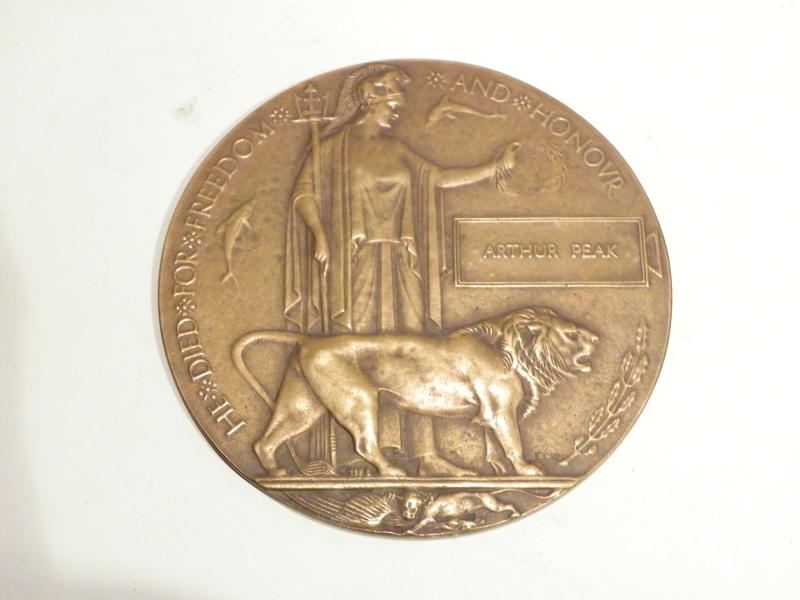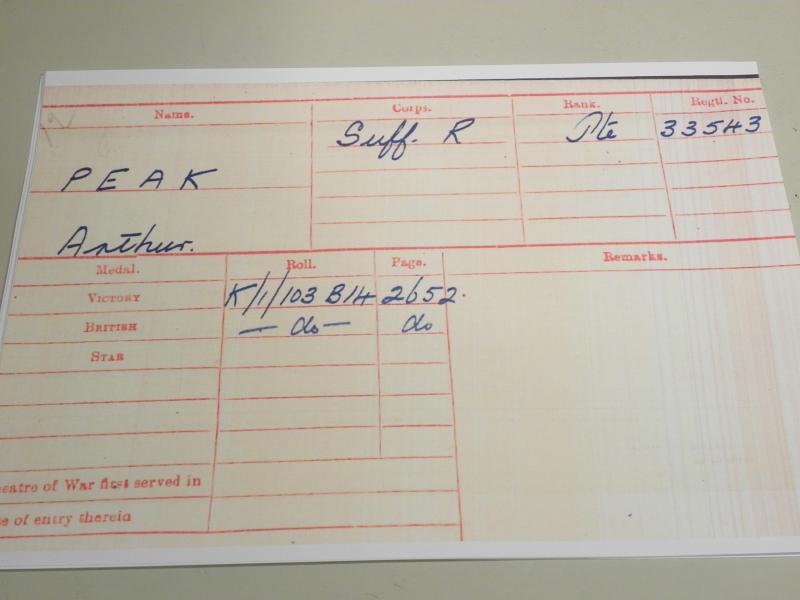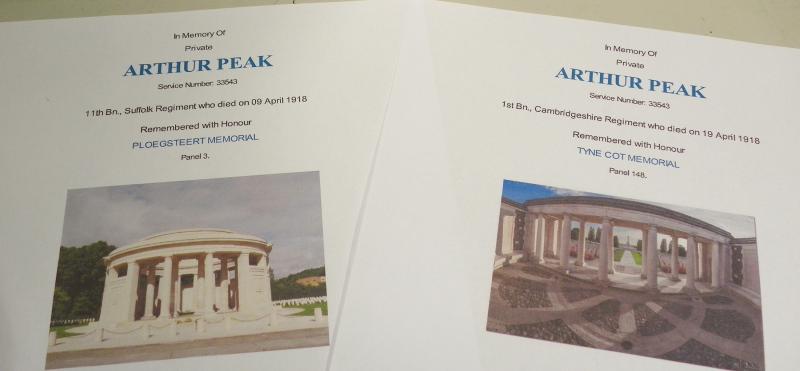WW1 Memorial Plaque to Peak 11th (Cambridge Battalion) Suffolk Regiment.
An interesting and scarce WW1 bronze memorial plaque named to Private Arthur Peak (unique name) of the 11th (Cambridge Battalion) Suffolk Regiment, who was killed in action during the savage fighting of the German Spring offensive of 1918.
Arthur Peak was born in Carlton Coville, Lowestoft Suffolk 1881. Lowestoft in those days was predominantly a Fishing town with a small harbour and with the building of the Railway in the 19th century, turned the little town around. During the first world war, Lowestoft became a Naval base for patrol boats, and it suffered a heavy bombardment by the German Navy in 1916. For the working classes of Lowestoft life was hard, most making their living from the sea. Arthur was no different, before the war he was employed as Fish Poacher in the fish market. He was married to Mable in 1903 and by the time war was declared he had one son and three daughters living at No 2 Cathcart Street in Lowestoft.
In 1915 he joined the 11th battalion the Suffolk regiment, the regiment was a form of Palls battalion raised in Cambridgeshire and the Isle of Ely, so it is unknown why he joined this regiment.
The battalion left Cambridge on 19th June 1915 to join 34th Division, which was assembling round Ripon in North Yorkshire. The 11th Suffolks camped at Fountains Abbey where it was brigaded with the 1st and 2nd Edinburgh Pals battalions and the Grimsby Chums in 101st Brigade. After training on the moors of North Yorkshire, 34th Division proceeded to Salisbury Plain in late August for final intensive training, with the 11th Suffolks at Perham Down Camp, later at Warminster.
On 13th December 34th Division was ordered to mobilise for service in Egypt, but these orders were rescinded on 26th December and instead the division embarked for France to join the British Expeditionary Force (BEF) fighting on the Western Front. Entrainment for the embarkation ports began on 7th January 1916 and the 11th Suffolks landed at Boulogne on 9th January. The division completed its concentration around La Crosse (east of Saint-Omer) on 15th January 1916. On 23 January 34th Division went into reserve behind III Corps, with 101st Bde around Morbecque. Parties were then sent into the line with 23rd Division near Erquinghem in the Armentières sector to learn the routines of Trench warfare; 11th Suffolks went up from 2 to 7 February, suffering its first casualties. On 21 February the division took over its own sector of the front line, with 101st Bde on the right, at the dangerous Bridoux salient, overlooked by the German positions on Radinghem Ridge. Over the following weeks the brigades were rotated between the frontline trenches and reserve. Most of April was spent in divisional training, then on 5th May the battalion entrained for the Somme sector. The 11th Suffolks were in reserve, then in support, and on 21st May went into the line on the division's right, facing the fortified ruins of La Boisselle. It then began periods of 6 days in the line alternating with 4 days of rest, until it went into camp behind Albert on 23 June. On the 1st day of the battle of the Somme, the 11th battalion was one of only two battalions of the Suffolks to be engaged in the bloody fighting on the 1st of July. With the 34th division its position was in the front line of the attack opposite the village of La Boisselle, with the 8th division on then lest and the 21st division on its right.
At 07.28, 2 minutes before Zero hour the Lochnagar mine was detonated obliterating a section of the German defences and creating a very large crater. The 11th allowing the debris to settle went over the top on time at 7.30 am. The attack was a disaster. The German defences had not been suppressed by the long bombardment, and although some of the 10th Lincolns were able to rush forward and occupy Lochnagar crater before the Germans, they and the 11th Suffolks following them up Sausage Valley were shot down by German machine gun teams who came out of their deep dugouts as soon as the British barrage lifted. The 11th went on to distinguish themselves at the capture of Scots and Sausage Redoubts, The Battles of Bazentin Ridge and Pozieres Ridge. In 1917 they fought in the The First and Second Battles of the Scarpe and the Battle of Arleux during the Arras Offensive. In August they were involved in the fighting at Hargicourt and in October they took part in The Third Battles of Ypres at the Broenbeek. On the 3rd of February 1918 they transferred to 103rd Brigade still with 34th Division. In 1918 they were in action in The Battle of St Quentin and then moved to Flanders seeing action in The Battle of Estaires, The Battle of Bailleul and The First Battle for Kemmel Ridge during the Battles of the Lys.
On the 20th March 1918, the view over the front line was all peace and quietness, one officer wrote it was hard to believe they were in the middle of a war, the Sensee valley looked restful with just the faint sound of working parties in the distance. However, the next dawn that broke was vastly different. The Germans opened with a heavy bombardment on the 11th battalion’s sector, then followed a bombardment of gas. The 11th was driven out of the front-line trench leaving many men dead behind. Then another heavy shelling took place on the battalion’s position followed by a German advance on their trenches. At this point chaos broke out, heavy hand to hand fighting, low flying planes were discharging machine gun fire, everywhere batteries were bustling into new positions. Severe fighting continued uninterruptedly all through the night and the following morning. The battalion was subjected to the heaviest and most concentrated bombardment it ever experienced. On the 22nd of March the battalion fought desperately to defend Henin Hill, all day the enemy tried again and again to force their way into the trenches until the German army finally withdrew leaving behind heavy casualties in the battalion.
But through all this Arthur was still with us, what he was experiencing we can only guess, from the little fishing town of Lowestoft to the very depths of hell. The 11th battalion was officially congratulated on there efforts by the commander of the division.
Around the 5th of April after a series of marches and a railway journey the battalion arrived at Erquinghem and made their way to the front line in the Houplines sector a short way, some 8000 yards in front of Armentieres. On the 7th the Germans bombarded the town with gas shells causing heavy losses and on the 8th the enemy opened with heavy shelling and on the 9th the battalion along with the rest of the brigade was sent south of Bac St Maur, here they were told to hold the line to protect flank of the 40th division. Terrific fighting followed, although the brigade was in reserve, due to a tactical anomaly, found themselves the first troops to face the enemy. Here they beat off attack after attack, twice the Germans broke through and were beaten back. From the 7th to 19th of April, the battalion were engaged in heavy fighting, gas attacks and bombing. Some of the battalions in the brigade got disorientated and mixed and it was a desperate struggle to stay alive. 33543 Private Arthur Peak was killed between the 9th and 19th April. His body was never recovered and for many of the 11th battalion they were just gone, no trace was found, bodies obliterated in the dense fighting and shelling.
It was so impossible to determine where and when Arthur was killed, unusually he is remembered with honour on two memorials, the Ploegsteert memorial and on the Tyne Cot memorial. He is also remembered at the Great War memorial chapel at St Margarets Church in Lowestoft.
His plaque is in excellent condition and comes with various research including copies of medal index card, medal roll, Commonwealth War Grave certificate and memorial details x 2, extracts from the war diary and census information etc.
Code: 29711
125.00 GBP







